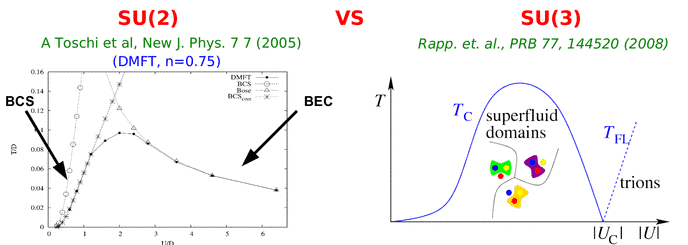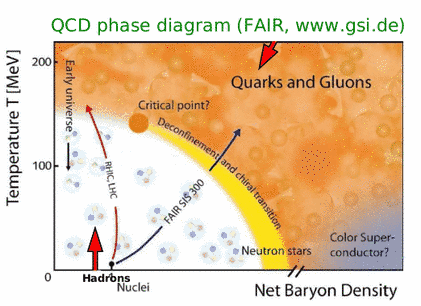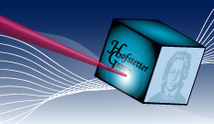Multiflavor Fermi gases
Cold atoms loaded in optical lattices provide us with an excellent tool to study prototypical model of condensed matter, like e.g. the Hubbard model, and in recent years remarkable progress has been achieved in the realization of the Hubbard Hamiltonian loading two hyperfine states of fermionic atoms in a optical lattice. However cold gases allows also to realize and control with remarkable accuracy also models that have no immediate counterpart in condensed matter. In particular since the role of the electronic spin is played by the hyperfine state of the atoms, there is no reason to not go beyond the usual N=2 case of condensed matter. In particular already the case with N=3 has been object of intense theoretical [1],[2] and experimental studies [3].
|
|
These system can be modelized using a generalized SU(N) attractive Hubbard model whose Hamiltonian is given by the formula above.
|
|
First studies on this model where first based on a generalized BCS approach [1], where it was shown that for small coupling the system is in the so-called color superfluid phase, where only two of the species are paired while the third stay unpaired. Using a variational Gutzwiller technique [2] it has been shown that the model undergoes a quantum phase transition between the color superfluid phase and a trionic phase at strong coupling where the full SU(3) symmetry is restored.
This is in striking contrast with the SU(2) case which has been studied in recent years as a model to understand pairing in High-temperature superconductors [4]. In this case the system is always in the superfluid phase for every value of the interaction and its properties evolve continuously evolve from a weak-coupling (BCS) limit to a strong coupling (BEC limit).
This transition shows a remarkable similarity with the transition between quark superfluid and barionic phase in the context of Quantum Chromo Dynamics, even though in that case the situation is much more involved because of the gauge field dynamics. Another very interesting property of this system is that superfluidity induce spontaneous magnetization in the system. In usual superconductors magnetization and superfluidity compete with each other giving raise to exotic phases like FFLO .Here instead the condensation energy gain in the pairing channel immediately lead to a spontaneous magnetization which should result in phase separation when considering systems where the total number of particle in each hyperfine state is conserved like cold gases in a trap.
|
|
|
|
References :
[1] C. Honerkamp and W. Hofstetter, Phys. Rev. B 70, 094521 (2004)
[2] Rapp et. al. , Phys. Rev. B 77, 144520 (2008)
[3] Ottenstaein et al., Phys. Rev. Lett. 101, 203202 (2008)
[4] Toschi et al., Phys. Rev. B 72, 235118 (2005)









